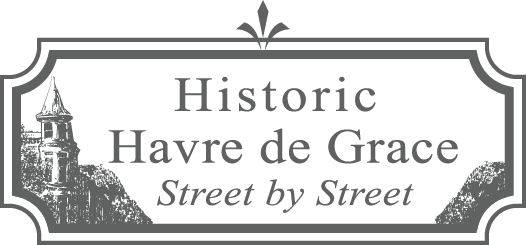Back to All Listings
200 North Union Avenue, Seneca Mansion,
200 North Union Avenue, Seneca Mansion,
c. 1867
Stop #14 on The Lafayette Trail
200 North Union Avenue on the northwest corner of Union and Pennington Avenues is named after Stephen J. Seneca (1837-1918), a local entrepreneur of the Victorian era, who built it. He had bought the land, stretching west to Freedom Lane, in 1862 from the Estate of Samuel Blackwell, Jr. (1791-1857), of Queens County, New York.
Stephen Seneca was Mayor of Havre de Grace from 1893–1894 and had a major influence on architecture through his relationship with the Philadelphia architect William Lewis Plack (1854-1944) and the buildings in the city designed by Plack (including the Methodist Church and the Old First National Bank Building). Seneca also was an officer with the First National Bank. He married Annie E. Mitchell Seneca (1840-1923) in 1864. Stephen Seneca’s wealth sprang from an extensive manufacturing complex that he and his brother, Robert Seneca, operated at the foot of Pennington Avenue a few blocks east.
This is probably the largest residence ever constructed in Havre de Grace with 22 rooms in the original layout of the house. Originally, an open second-story porch, with spindles and rails, sat atop the first-floor porch. In 1867, Stephen Seneca deeded the house to his wife, Annie, and they are believed to have resided here for many years. In 1922, after Stephen’s death, she deeded the property to her niece, Annie Seneca Sharp (1898-1991), wife of Dr. C. Clifford Sharp. After mortgaging the property in 1934, however, the Sharps lost the property to the Home Owners’ Loan Corporation in 1940. They sold the property at public auction to Dr. Franklin Henry “Frank” Wolbert (1904-1967) in 1941.
Dr. Wolbert lived with his mother (Carolyn Champney Burlingame “Carrie” Wolbert, 1870-1955) and his brother (Dr. Charles M. Wolbert, 1898-1957) and also had his medical practice in this house. He is believed to have delivered many babies in Havre de Grace including Martha Dennis who says her father paid Dr. Wolbert with a case of whiskey because it was during WWII and cash was scarce. Others he delivered were Cecil Hill, Sr. in the hospital, and some in a maternity home he established in the 1940s nearby off Robin Hood Road. The land there also had a popular swimming hole known as Dr. Wolbert’s Beach (where local Jim Miller remembers swimming in the 1970s). People remember seeing snakes in the rocks as kids, and that baptisms were held there annually. Joann Jewell says her mother was baptized in that water in 1960 and died in a car accident on Robin Hood Road the following year.
Many stories exist about the eccentric Dr. Wolbert and his kindness to children as well as about the décor in this house. Sally Lieske Daigle says that when she was scared at her doctor appointments, he would play the piano for her. Dr. Wolbert’s mother is also known to have played the piano sometimes across from his waiting room. But she is remembered best for taking patients’ hats and coats on their arrival and hiding them around the house! The décor included medieval suits of armor, baby alligators that he fed with chickens in his greenhouse, a collection of shrunken heads, a Christmas card room in the basement where cards were taped all over the walls and ceiling, a collection of beautiful clocks in his office, and a circular bed that Dr. Wolbert is said to have won on “The Price is Right” TV program. It isn’t possible to verify all of these stories but they, and more, have been written about and discussed for years—William R. Pyle assures us that Wolbert only kept small alligators, confirmed by Carole B. Shelor.
Dr. Wolbert’s life was ended suddenly in August 1967 when a young man he had befriended and brought to his home murdered him and fled the city in Dr. Wolbert’s Cadillac. An AWOL Marine for six months, he was arrested near Fredericksburg, Virginia, in the Cadillac, confessed to having already killed his commanding officer before going AWOL, and then strangling Dr. Wolbert. Dr. Wolbert’s estate was devised to John Norman “Jack” Wolbert (1907-1988), whose wife, Anna, died in 1969. In his own will, Jack Wolbert established a trust, leaving his estate to Ann Wolbert Burgess and Wade B. Wolbert, Trustees.
Ann Wolbert Burgess, D.N.Sc., APRN, FAAN, is an internationally recognized pioneer in the assessment and treatment of victims of trauma and abuse and is considered one of the foremost experts in forensic nursing. Born in 1936, she is a Professor at Boston College. Ann has written of visiting her “Uncle Frank” in Maryland in her early teens and helping him to deliver babies—and being surprised when patients would leave such gifts as a basket of apples on his porch the next day.
In 2012, this property was conveyed by Ann Wolbert Burgess and Wade Wolbert to Ann W. Burgess and Allen Gordon Burgess, Trustees of the Ann Wolbert Burgess Trust, which continues to be the owner.
West of the house on the corner of Freedom Alley is a large board and batten carriage house with a clipped gable on the south elevation and a jigsaw barge. The louvered vent on top of the gable roof repeats the clipped gable and jigsaw barge motif of the main structure. The building, known as 201 Pennington Avenue, is used for rental housing. Between this carriage house and the main house are two or three small cottages that are also rented out.
County Records
Built 1880. 6,267 sq ft, apartments, 2.5 stories with basement, 5.5 baths, .41 acre lot.
Built 1880. 6,267 sq ft, apartments, 2.5 stories with basement, 5.5 baths, .41 acre lot.
